Author: Mike Edmisten
Source
Michigan anglers have reeled in some eye-popping catches over the years. This comes as little surprise, given the bountiful fishing opportunities that exist in the state. Michigan has the second-highest coverage of territorial inland waters among all U.S. states. Only Alaska has more square miles of water than the Wolverine State. Michigan boasts over 10,000 lakes of five acres or more. No point in Michigan is more than six miles from one of the state’s inland lakes. There is also no point in the state more than 85 miles from one of the Great Lakes. With so many fishing opportunities, Michigan anglers have an embarrassment of riches at their fingertips, and they have put it to good use by posting some crazy numbers in the state’s fishing record book. Here’s a look at the 25 largest fish ever caught in Michigan.
This list includes every Michigan fishing record of ten pounds or more. All the information regarding species, size, date, location, and fishing method was sourced from Michigan’s Department of Natural Resources (DNR) website. World record information was collected from the International Game Fish Association (IGFA) website. IGFA is sportfishing’s governing body and keeper of official fishing world records.
25. Hybrid White Bass

Weight: 10.75 pounds
Length: 27.5 inches
Water Body: Kalamazoo River
Year: 1996
Method: Drift fishing
Bait/Lure: Steelhead Spawn
The hybrid white bass (Morone chrysops x Morone saxatilis) is a hybridization of a striped bass and a white bass. These fish are also known as whiterock bass, hybrid striped bass, or simply hybrids. Colloquially, these fish are sometimes called “wipers,” combining “white bass” and “striper.” This hybridization rarely occurs naturally but instead is created in hatcheries.
The hybrid white bass is an aggressive predator, feeding mainly on other fish including shad, crappie, bluegill, and other smaller fish. The 10.75-pound Michigan record was a hefty fish, to be sure, but hybrids can grow significantly larger. While a typical fish weighs from two to five pounds, these hybrids can reach 20+ pounds.
23. (tie) Largemouth Bass
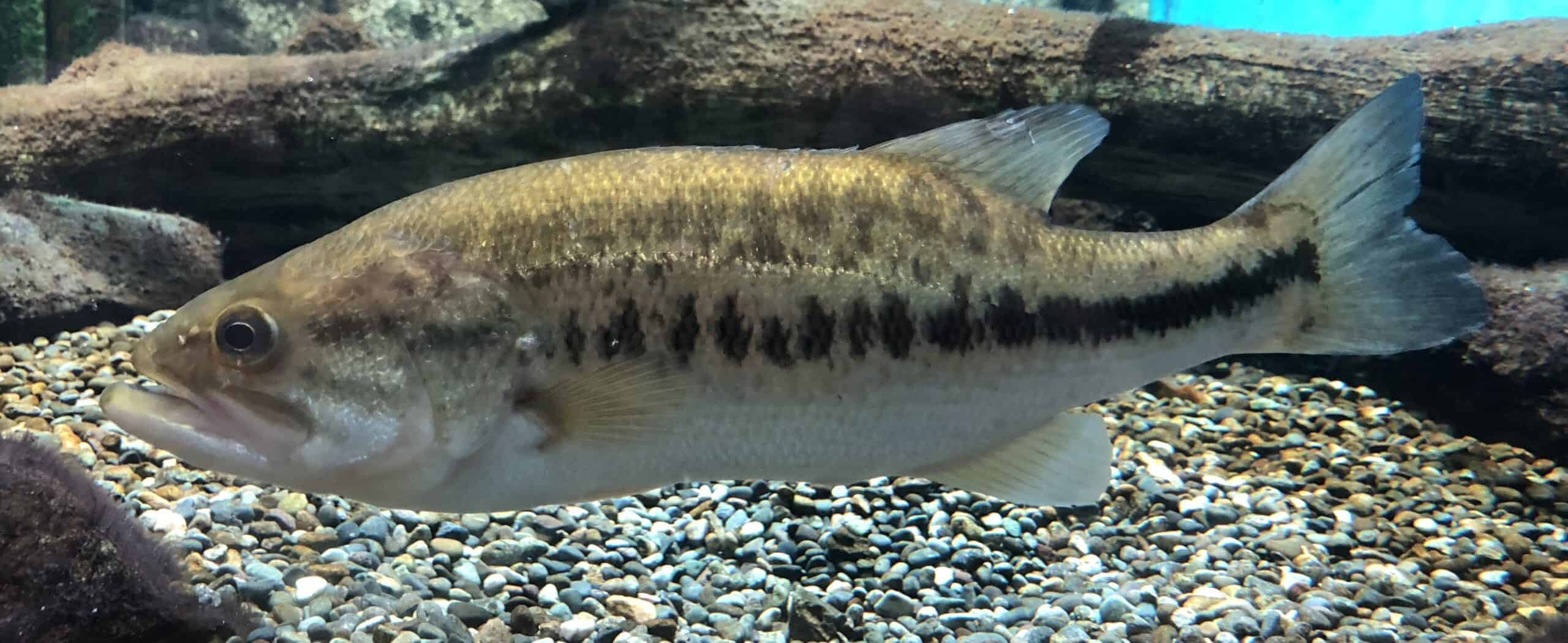
Weight: 11.94 pounds
Length: 27 inches (1934); 26 inches (1959)
Water Body: Big Pine Island Lake (1934); Alcona Dam Pond (1959)
Years: 1934 & 1959
Method: Unavailable
Bait/Lure: Unavailable
The largemouth bass (Micropterus salmoides) is the most popular freshwater game fish in North America and for good reason. It is an aggressive predator and a strong fighter. Its oversized “bucketmouth” allows the fish to target prey up to half its size.
Two fish share the record for the biggest largemouth bass ever documented in Michigan. The record was set in 1934 with an 11.94-pound largemouth bass. Twenty-five years later, the record was tied with an identically weighted largemouth. The 1934 fish measured one inch longer, but fishing records are determined by weight, not length.
A typical mature largemouth bass can weigh from one to five pounds. However, the U.S. and world record largemouth weighed a staggering 22 pounds, 4 ounces. That fish was caught in Georgia in 1932. (It was later tied by a bass caught in Japan in 2009.) It is unlikely that Michigan will ever yield a bass that size due to its cold winters.
In southern states, largemouth bass feed all year round due to the temperate conditions. In cold weather states, these bass enter torpor during the winter where they rarely feed. Generally speaking, the biggest largemouths will always be found in the southern U.S. or other warm-weather states such as California. This takes nothing away from the Michigan record, though. A nearly 12-pound largemouth is still a lunker!
22. Redhorse Sucker
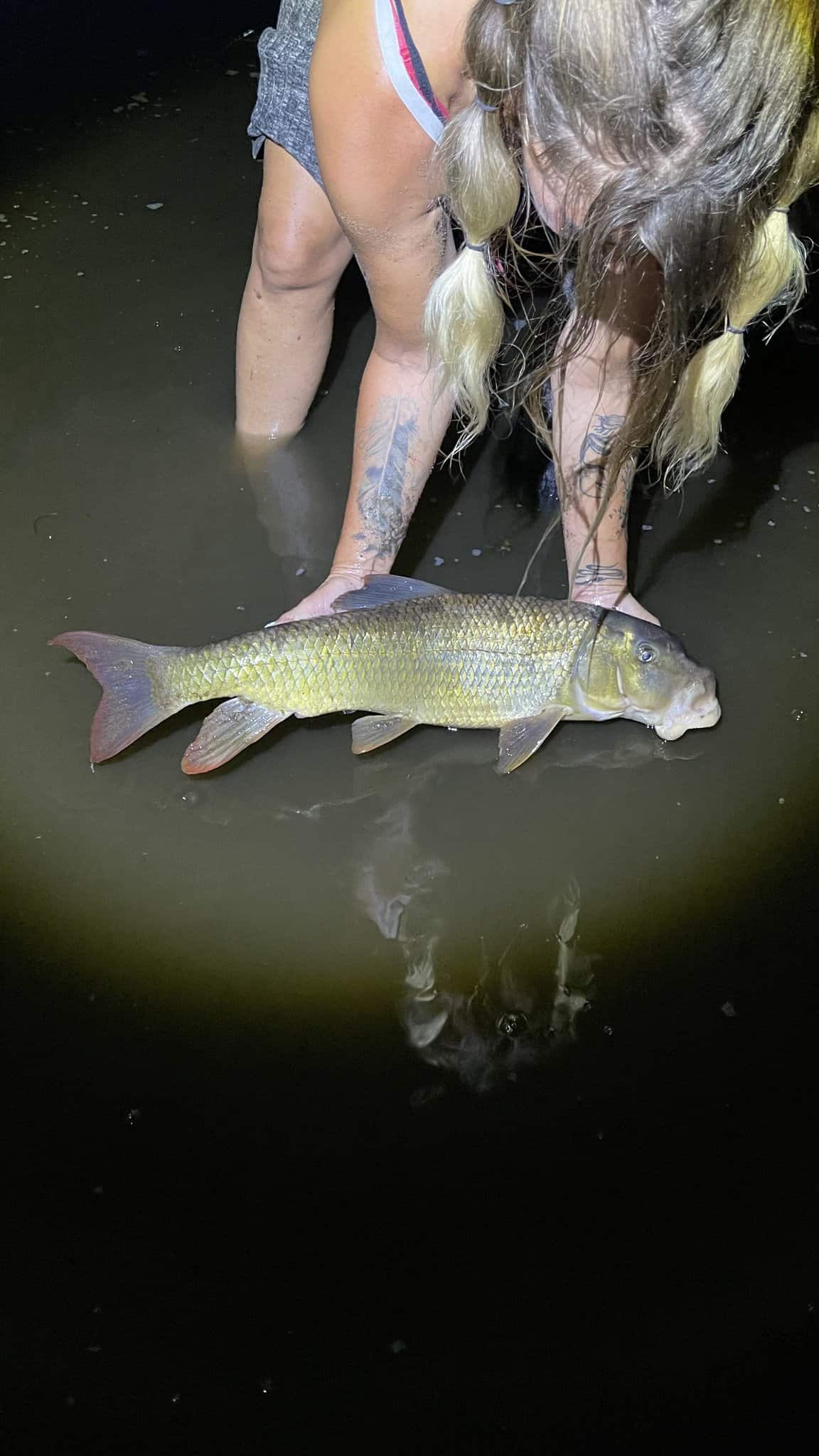
Weight: 12.89 pounds
Length: 29.25 inches
Water Body: Muskegon River – Croton Pond
Year: 1991
Method: Baitcasting
Bait/Lure: Nightcrawler
The redhorse sucker (Moxostoma carinatum) is native to the east-central United States and southeastern Canada. The redhorse sucker, also known as the river redhorse, is the largest of six redhorse species in Michigan.
A mature redhorse sucker grows from 10-20 inches and weighs from one to four pounds, but they will readily grow to 8+ pounds under the right conditions. The nearly 13-pound Michigan record was an absolute monster. That record may never be broken, not only because that 1991 fish was so large, but because redhorse suckers are disappearing from the state.
These fish are typically found in medium to large rivers with gravel bottoms, though they can sometimes be found in smaller streams and lakes. Redhorse suckers thrive in clean water and cannot tolerate high pollution levels. Populations of redhorse suckers have become segmented due, at least in part, to uninhabitable stretches of rivers with impaired water quality. The fish is listed as a threatened species in Michigan. Fewer than ten populations of the fish are known to exist in the state.
21. Bowfin
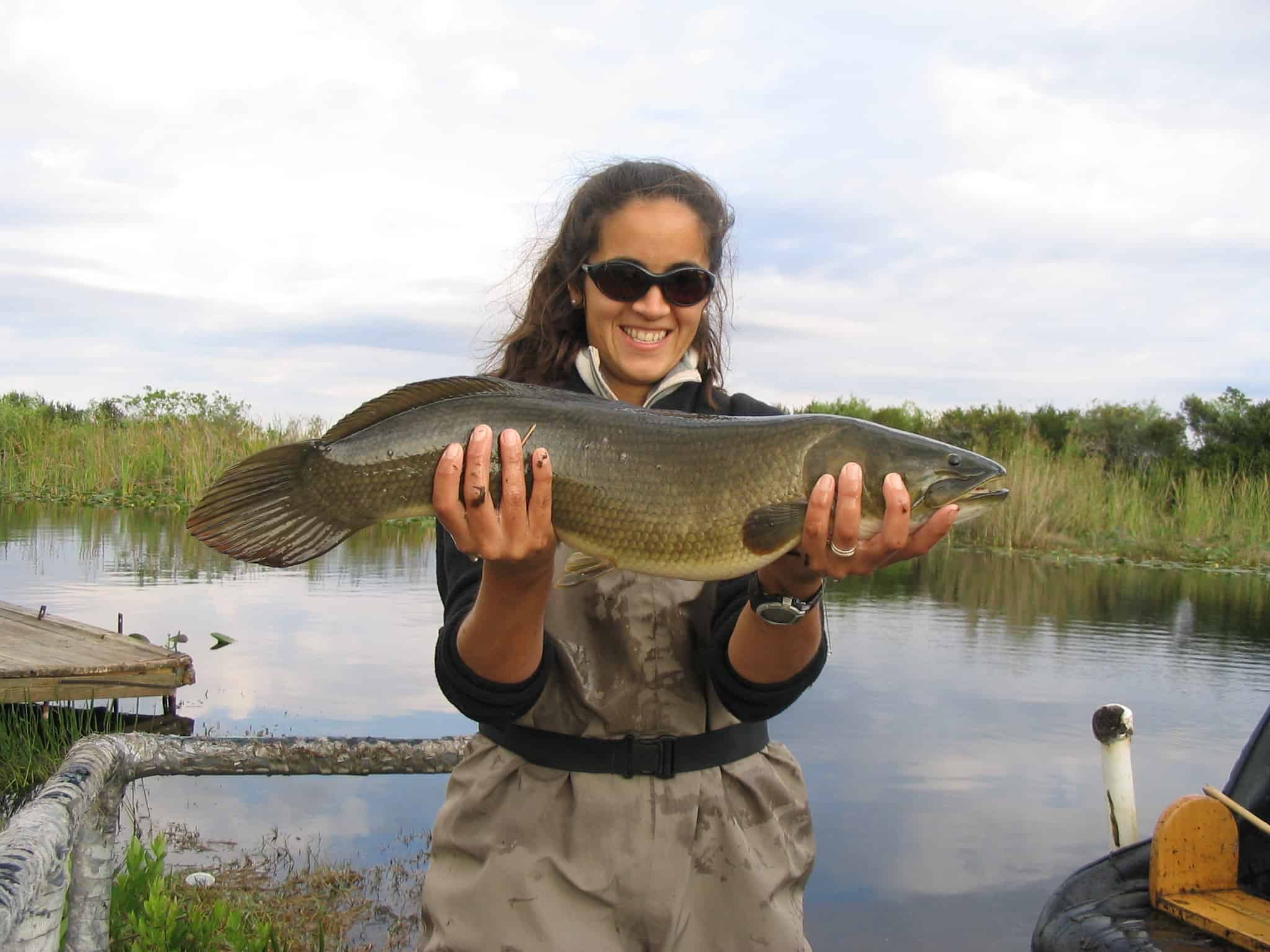
Weight: 14 pounds
Length: 35 inches
Water Body: Crooked Lake
Year: 1981
Method: Unavailable
Bait/Lure: Spinner
The bowfin (Amia calva) is a primitive fish dating back an estimated 200 million years. This “living fossil” has not changed much from its ancient ancestors.
The bowfin is named for its dorsal fin which covers nearly half of its back. It is a bimodal breather, meaning it can breathe both air and water. This allows the fish to thrive in a wide variety of conditions. Bowfin can be found in oxygen-rich streams as well as the low-oxygen conditions of backwaters and swamps. Its ability to live in the muckiest environments earned it nicknames such as “mud pike” and “mudfish.”
An average mature bowfin measures 20-30 inches and weighs from four to ten pounds. While it is typically disregarded as table fare, the bowfin is an aggressive, hard-fighting fish that will give any angler a run for their money.
20. Lake Whitefish
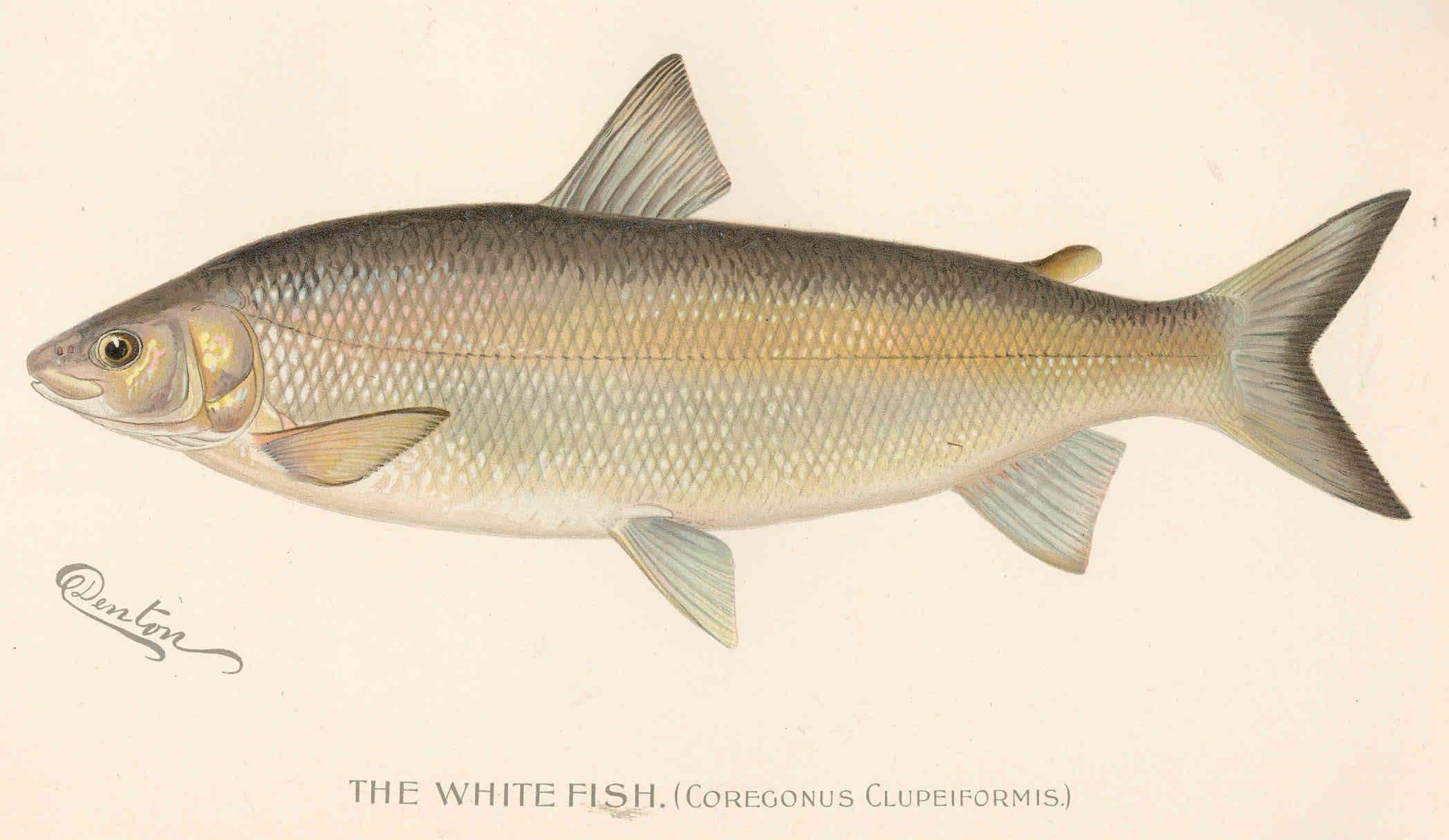
Weight: 14.28 pounds
Length: 31.75 inches
Water Body: Lake Superior
Year: 1993
Method: Trolling
Bait/Lure: Rebel
The lake whitefish (Coregonus clupeaformis) is a cold water fish that is found in Alaska and throughout Canada. Its range in the 48 contiguous U.S. states runs from Minnesota through the Great Lakes to New England.
A typical mature lake whitefish can grow 17-22 inches long and weigh from 1.5-4 pounds. It is highly prized as table fare. The fillets are firm with a large flake. The taste is delicate with no strong fishy flavor.
The Michigan record lake whitefish was a giant that was less than two ounces shy of setting a new world record. The world-record lake whitefish weighed 14 pounds, 6 ounces. It was caught in Ontario in 1984.
19. Walleye
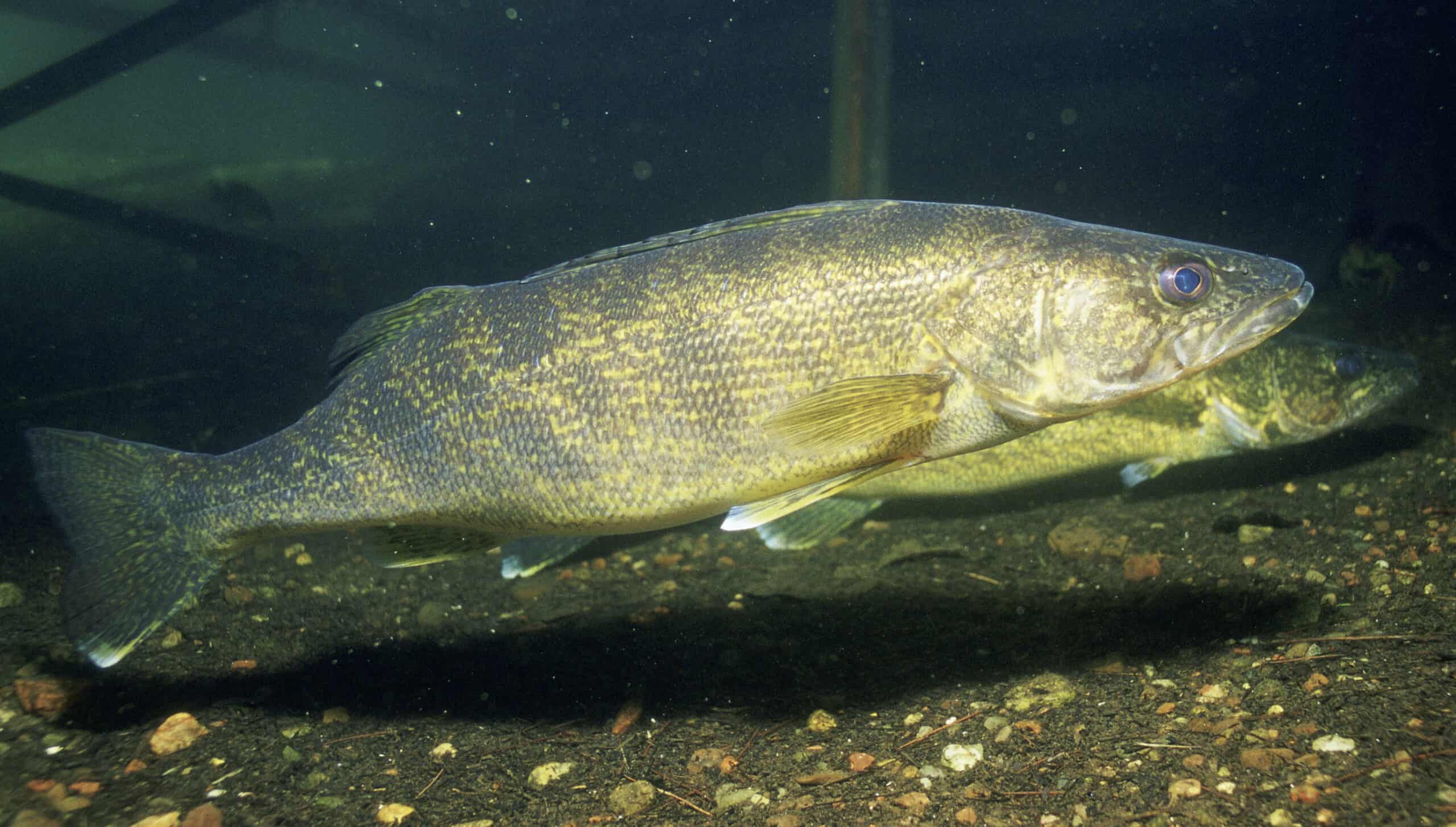
Weight: 17.19 pounds
Length: 35 inches
Water Body: Pine River
Year: 1951
Method: Unavailable
Bait/Lure: Live Minnow
The walleye (Sander vitreus) is native to much of Canada. In the U.S., its native range stretches from the Dakotas in the west to New York in the east. It also stretches south to Arkansas and South Carolina. The walleye has been introduced far beyond its native range, though. The fish is now found in all 48 states in the conterminous U.S.
An adult walleye normally measures 14-22 inches long and weighs two to four pounds, but these fish can grow significantly larger. Walleye over ten pounds are not uncommon. As seen in Michigan’s state record, individuals can sometimes tip the scale at 17+ pounds.
The walleye have a mouthful of sharp teeth that it uses to snag its prey of other fish. It has keen eyesight, so it hunts most often at night or in other low-light conditions where it has an advantage over its prey. Cloudy weather, turbid water, or rough, wavy conditions (known as “walleye chop” among some anglers) are all prime times for walleye to go on the hunt.
Walleye is a favorite among Michigan anglers. It is an excellent sportfish. It is also among the best-tasting freshwater fish in the U.S.
18. Splake
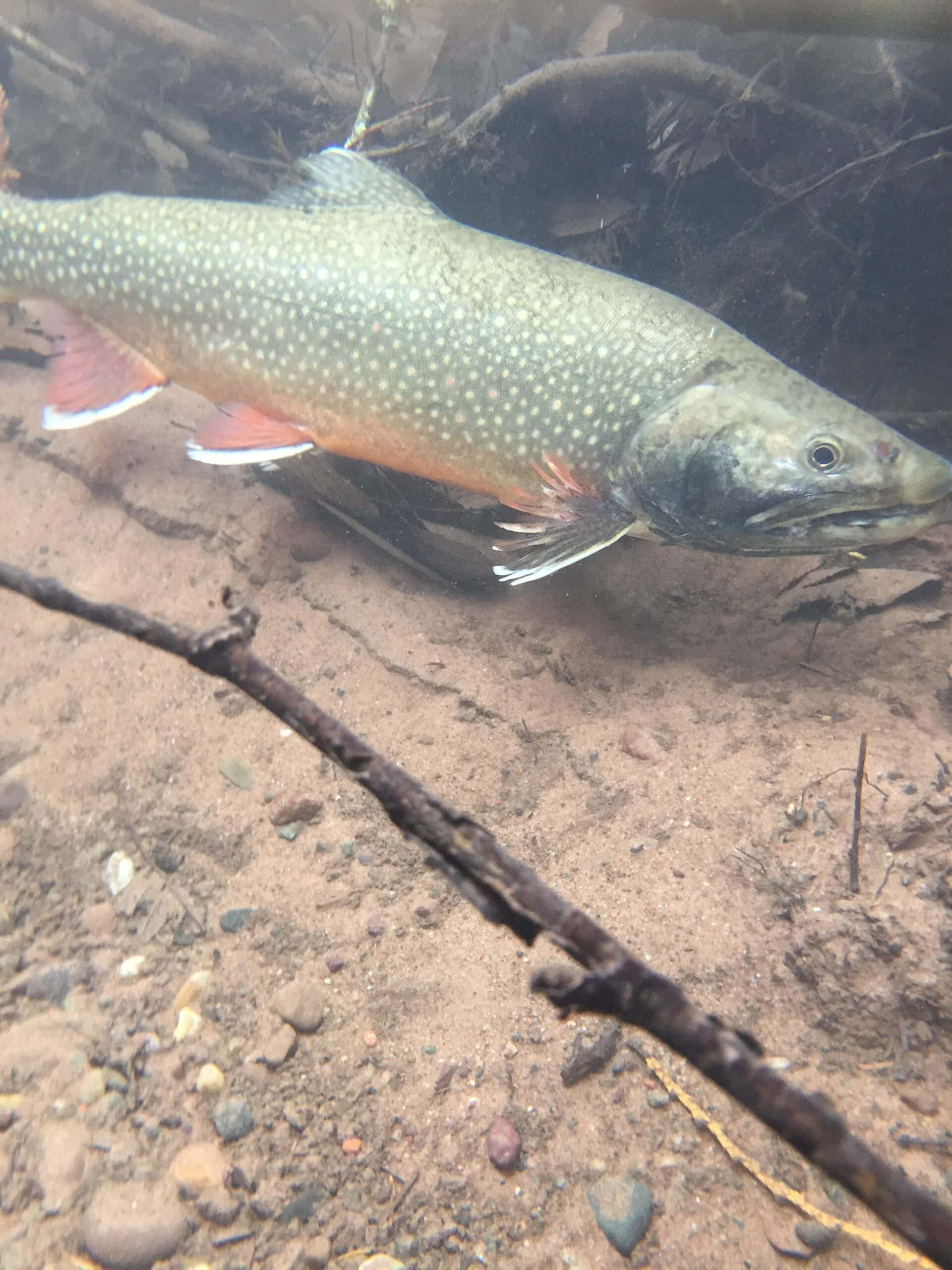
Weight: 17.5 pounds
Length: 34.5 inches
Water Body: Lake Michigan – Big Bay De Noc
Year: 2004
Method: Spincasting
Bait/Lure: Kast Master
The splake, sometimes known as the slake, (Salvelinus namaycush x Salvelinus fontinalis) is a hybrid of a male brook trout and a female lake trout. The splake’s name is a combination of “speckled” and “lake.” Speckled trout is the common name of the brook trout. “Lake,” of course, comes from the lake trout.
This brook/lake trout hybridization does not occur naturally but instead is produced in hatcheries. Unlike many other hybrid fish, the splake is capable of reproducing, but such reproduction is relatively rare. Artificial stocking is the only way to maintain the splake population.
Splake anglers commonly catch fish weighing from two to four pounds, though fish over seven pounds are common. The 17.5-pound monster caught in Lake Michigan is only a few pounds off the world record. A 20-pound, 11-ounce splake was caught in Georgian Bay in Ontario in 1987.
Splakes are scrappy fish that are a blast for Michigan anglers, including ice-fishing enthusiasts. They also make oustanding table fare.
17. Longnose Gar
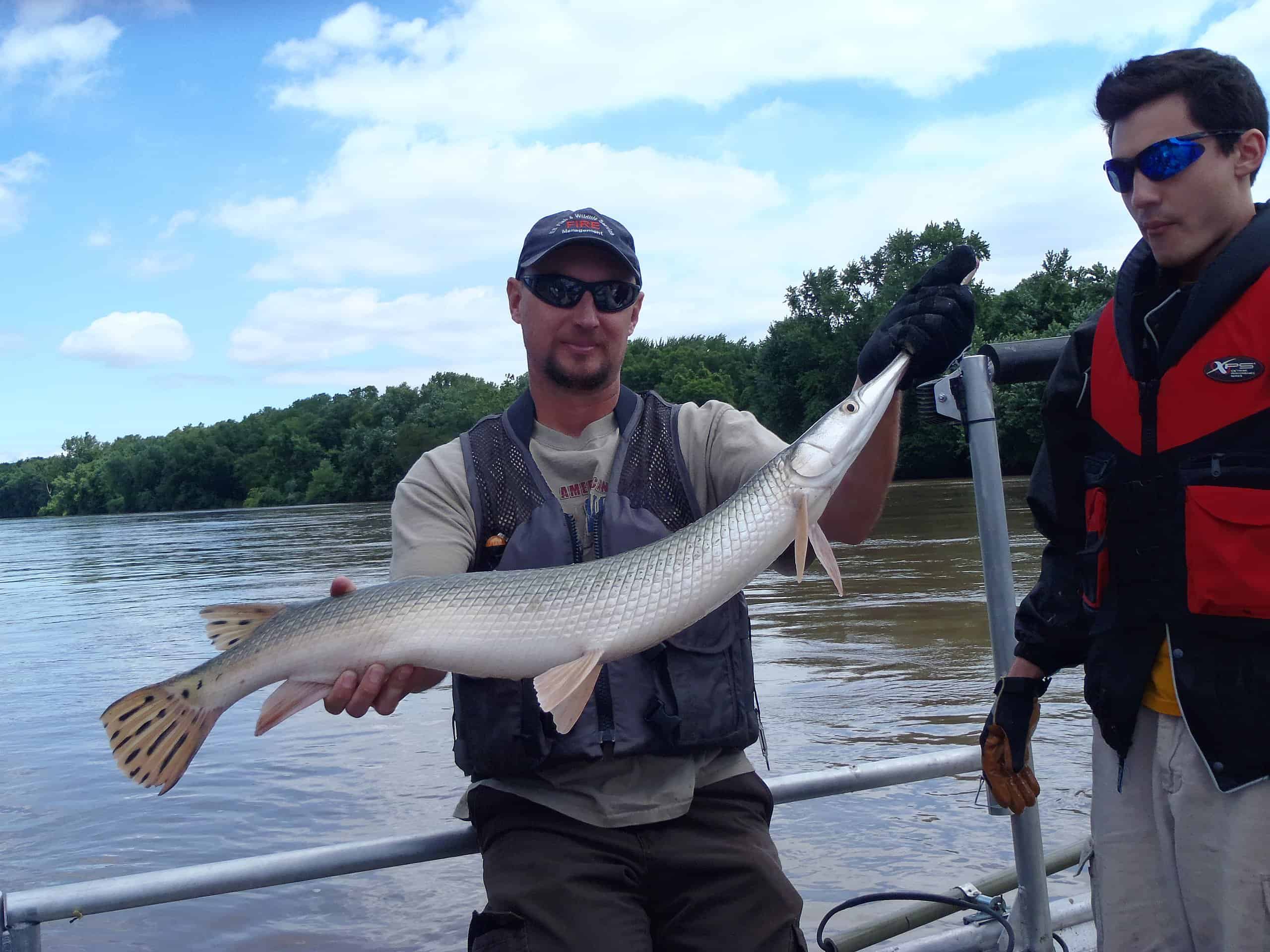
Weight: 18 pounds
Length: 53 inches
Water Body: Williamsville Lake
Year: 1995
Method: Spincasting
Bait/Lure: Green Rattle Trap
If the longnose gar (Lepisosteus osseus) looks prehistoric, that’s because it is. Remains of this primitive fish have been found dating back to the Cretaceous period.
The longnose gar is an elongated fish with a long snout filled with small sharp teeth. Like the primitive bowfin, longnose gar can breathe both water and air. This allows them to survive in low-oxygen conditions. It also means that Michigan anglers can target them in the hottest parts of summer. The oxygen level drops in warm water, meaning sportfish such as bass reduce their activity. The longnose gar can keep right on feeding, though, since it can come to the surface to breathe air.
The longnose gar is not a top sportfish in Michigan, but it should not be overlooked. It is an aggressive predator and a fiercely hard-fighting fish. This gar is found in all of Michigan’s Great Lakes except Lake Superior. It is also found in many other Michigan lakes, streams, and rivers.
16. Burbot
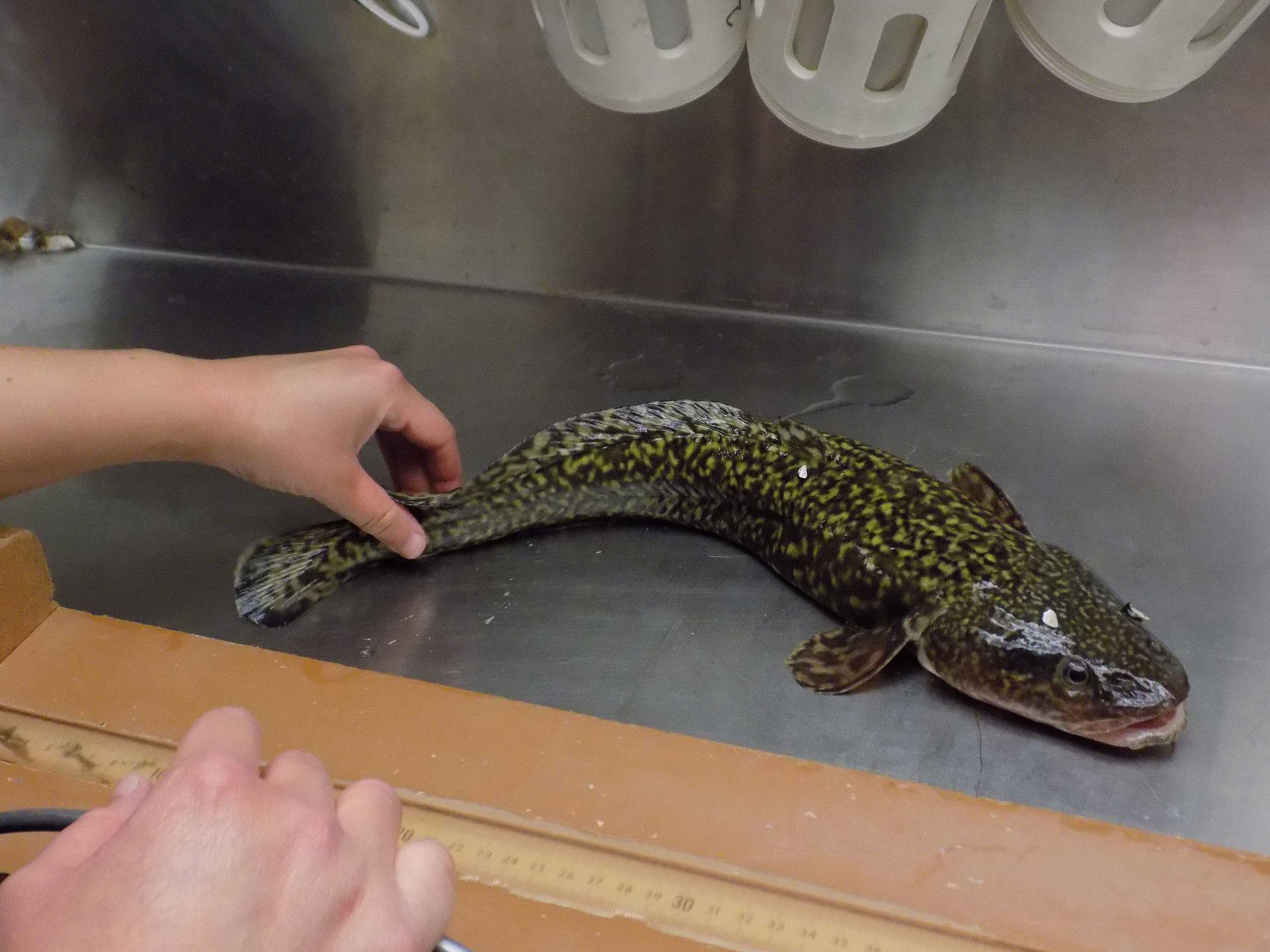
Weight: 18.25 pounds
Length: 40 inches
Water Body: St. Marys River – Munuscong Bay
Year: 1980
Method: Unavailable
Bait/Lure: Cleo
The burbot’s (Lota lota) appearance is often described as a cross between a catfish and an eel. It is the only member of the cod family (Lotidae) that lives exclusively in freshwater.
The burbot is found throughout Alaska, much of Canada, and the northern contiguous U.S. Its presence in Lake Michigan and other Great Lakes was decimated by the invasive sea lamprey, but restoration efforts are helping the burbot stage a comeback.
Mature burbots prey on other fish, including lamprey, whitefish, juvenile northern pike, suckers, perch, and trout. An average burbot measures around 28 inches and weighs around 8 pounds. They are ferocious predators and, while not among the state’s more popular sportfish, have become a favorite for some Michigan anglers.
15. Freshwater Drum

Weight: 28.61 pounds
Length: 34.02 inches
Water Body: Muskegon Lake
Year: 2015
Method: Unavailable
Bait/Lure: Unavailable
The freshwater drum (Aplodinotus grunniens) is so named because of the “drumming” sound made by the muscles in its swim bladder. It is also colloquially known as the sheepshead.
A typical adult freshwater drum can measure from 12-20 inches long and weigh from two to ten pounds. Freshwater drum are often caught by anglers who are targeting more popular game fish species, but these fish are not to be overlooked. They are muscular fish that put up a stout fight.
Far from a “trash fish,” the freshwater drum may be adapting to eat invasive zebra mussels, making it an invaluable Michigan resource.
14. Coho Salmon
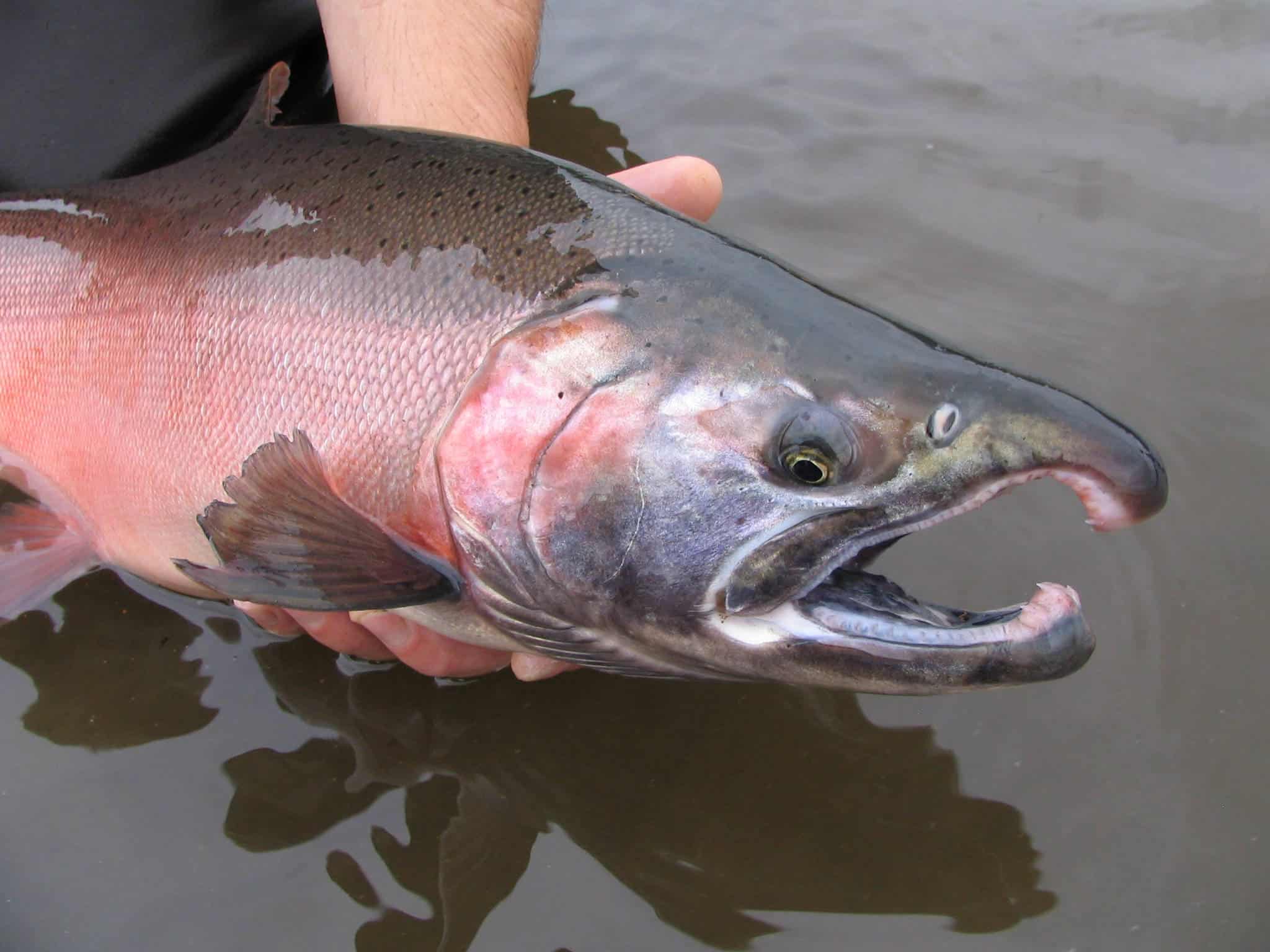
Weight: 30.56 pounds
Length: 40 inches
Water Body: Platte River
Year: 1976
Method: Spincasting
Bait/Lure: Spawn Sack
The coho salmon (Oncorhynchus kisutch) is the fish that gave rise to the Great Lakes salmon fishery. It is one of the most prized salmon species in Michigan, both as a sport fish and as a delicious food fish.
Coho salmon typically measure one to two feet long and weigh 5-12 pounds. Cohos weighing 20+ pounds are not uncommon.
While not part of the fish’s native range, the coho salmon is now found in all of the Great Lakes. It is also found in many Michigan rivers at different times of the year, including the Manistee River, Platte River (where the state record coho was caught), St. Joseph River, and Anna River.
13. Atlantic Salmon

Weight: 32.62 pounds
Length: 41 inches
Water Body: Lake Michigan
Year: 1981
Method: Trolling
Bait/Lure: Lucky Lure
In its native range, the Atlantic salmon (Salmo salar) is anadromous, meaning it lives in saltwater but spawns in freshwater. Because of its ability to survive in freshwater, the fish has been spread beyond its original coastal range.
Stocking of Atlantic salmon in Michigan began in 1972 when 20,000 fish were placed in the Boyne and Au Sable rivers. Today, prime places for Michigan’s Atlantic salmon include the St. Mary’s River, St. Clair River, Torch Lake, and Lake Huron. The fish was stocked in Lake Michigan until the 1990s.
A typical Atlantic salmon in Michigan weighs 8-10 pounds. The fish is a favorite of both fly fishers and spinning tackle anglers. Anyone who targets Atlantic salmon knows the fish’s acrobatic leaps once it is hooked provide an experience like no other.
12. Bigmouth Buffalo
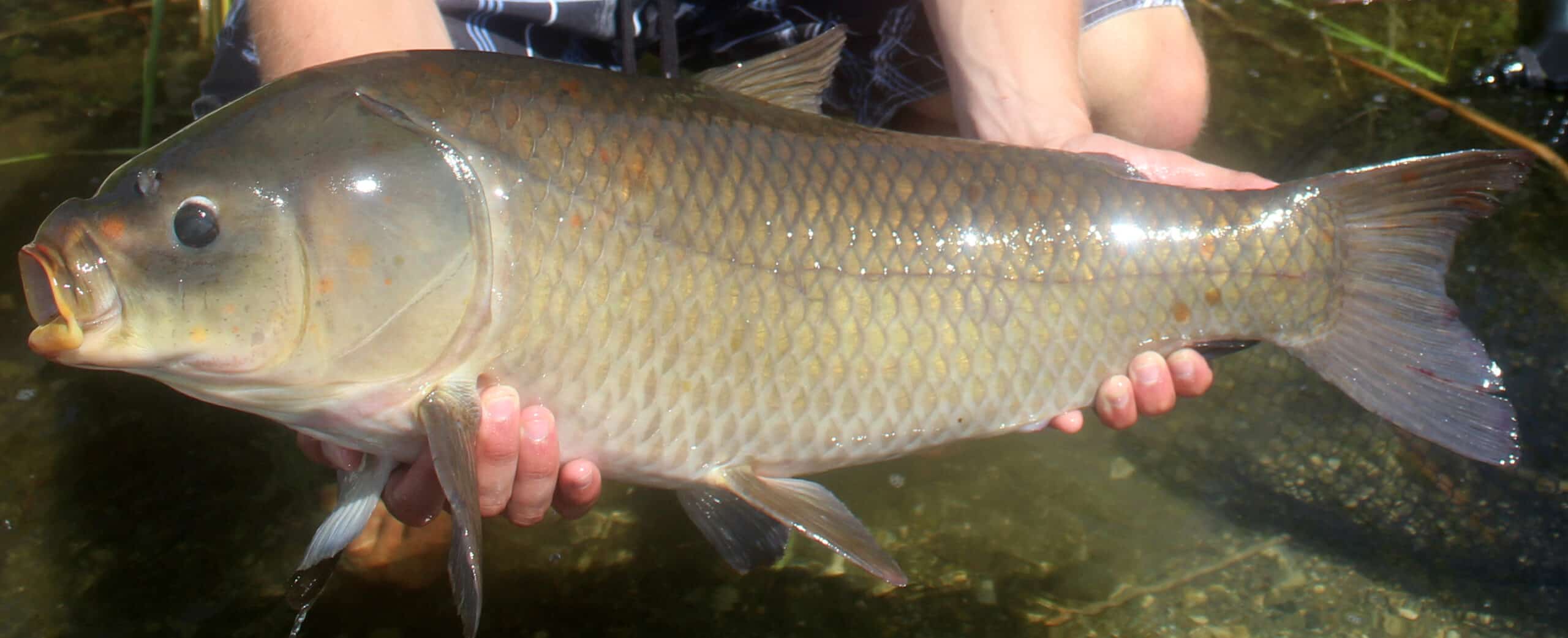
Weight: 33 pounds
Length: 36.25 inches
Water Body: Lake Erie
Year: 2020
Method: Bowfishing
Bait/Lure: N/A
The bigmouth buffalo (Ictiobus cyprinellus) is the largest of any suckerfish species in North America. It is also remarkably long-lived, often living 80-100 years or longer. The oldest bigmouth buffalo on record was 112 years old, making it the oldest recorded freshwater fish in history.
These supercentenarian fish are sadly viewed as “trash fish” by many anglers. They are generally disregarded as table fare and many pass them over for more prized game fish.
A mature bigmouth buffalo typically measures 15–27 inches long and weighs 5-15 pounds. A bowfishing angler caught the 33-pound Michigan record bigmouth buffalo in 2020. Bowfishers use archery equipment instead of a rod and reel. Along with buffalo fish, Michigan bowfishers also target species such as burbot, carp, catfish, drum, gar, and whitefish.
10. (tie) Channel Catfish
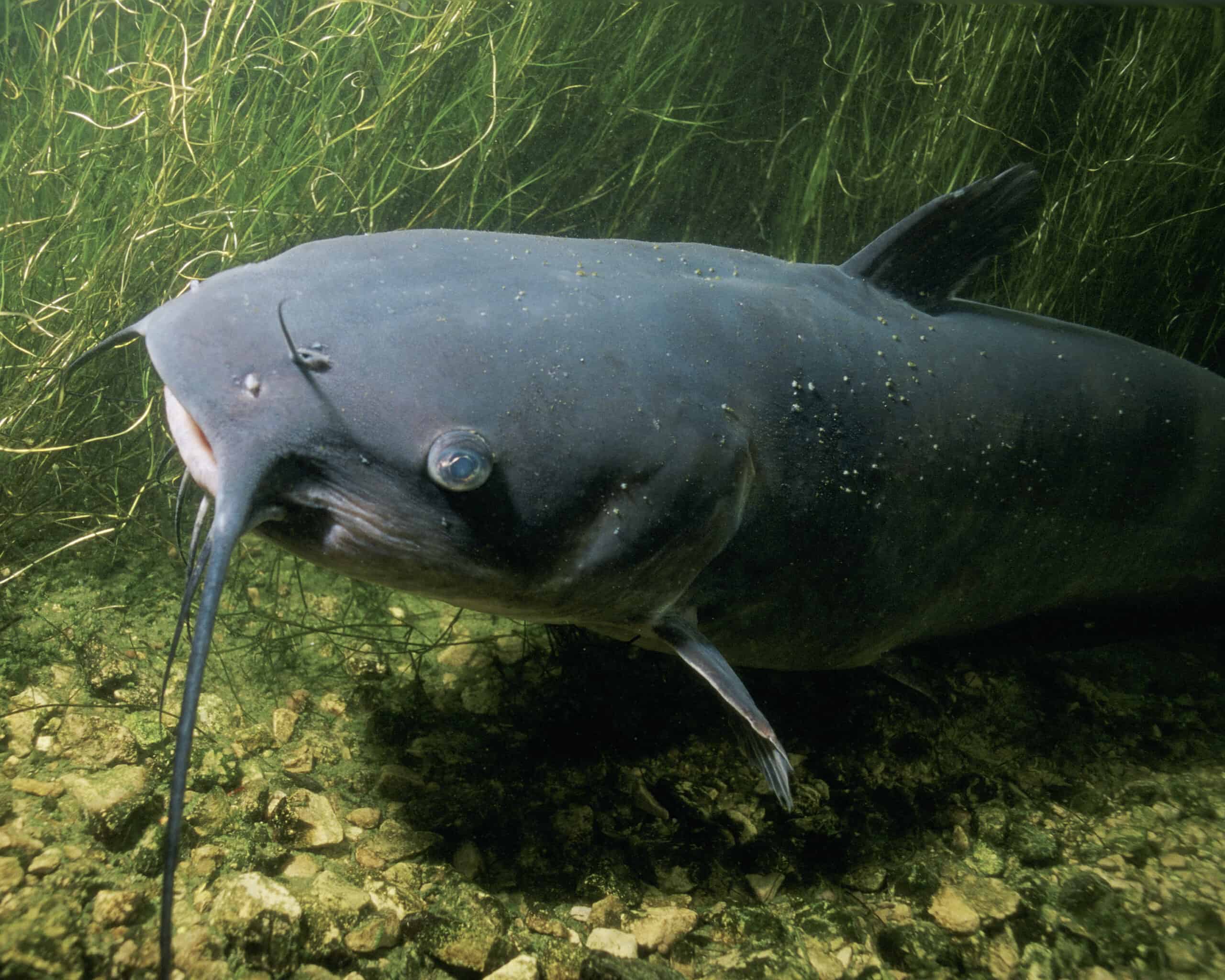
Weight: 40 pounds (tie)
Length: 41.5 inches – 1964 (length of 1960 fish is unavailable)
Water Body: Houghton Lake
Years: 1960 & 1964
Method: Unavailable
Bait/Lure: Unavailable
The channel catfish (Ictalurus punctatus) is the most widespread catfish species in North America. It is also the most popular among U.S. anglers.
Channel cats are the smallest of the “Big Three” catfish, which includes flathead and blue catfish, but they can still grow to prodigious sizes. Fish weighing two to four pounds are the norm, but channel catfish weighing 10-15 pounds are also quite common. Channel catfish are also among the most sought-after freshwater fish for table fare.
Channel catfish live in all of the Great Lakes except Lake Superior. They also proliferate in many other Michigan lakes and large rivers.
9. Brown Trout

Weight: 41.45 pounds
Length: 43.75 inches
Water Body: Manistee River
Year: 2009
Method: Spincasting
Bait/Lure: Rapala Shad Rap
The brown trout (Salmo trutta) is native to Europe and parts of Asia. The fish was introduced in Michigan in 1883, one of the first introductions of the fish in North America.
Brown trout thrive throughout Michigan but are especially abundant in central and northern Michigan waterways such as the Pere Marquette, Manistee (where the state record was caught), and Au Sable rivers. They also populate the Great Lakes, particularly Lake Michigan, and many inland lakes, especially in northern Michigan. However, because “brownies” can tolerate warmer water temperatures than other trout, they can also be found in some more southerly streams in Michigan.
Brown trout are not as highly regarded for table fare as some other trout species, but they are certainly a favorite among Michigan anglers.
8. Chinook Salmon
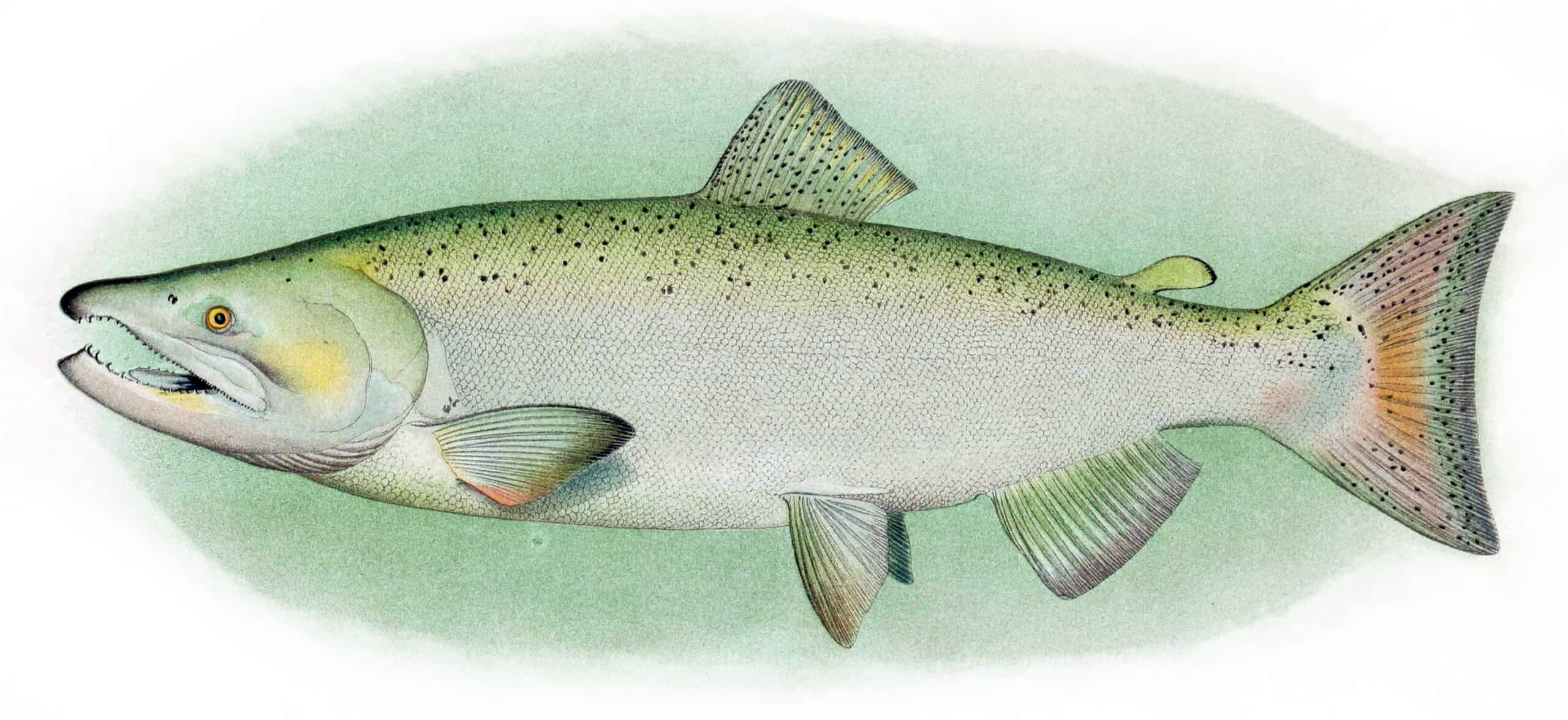
Weight: 47.86 pounds
Length: 47.5 inches
Water Body: Lake Michigan
Year: 2021
Method: Trolling
Bait/Lure: Moonshine Spoon
The chinook salmon (Oncorhynchus tshawytscha) is the largest species of Pacific salmon. Stocking efforts in the Great Lakes began in the 1870s, but the fish wasn’t firmly established until the late 1960s. It is now the top species for the Great Lakes salmon fishery.
Chinooks are found in all of the Great Lakes, with Lake Michigan as the leading fishery for this salmon. The state record chinook was caught in Lake Michigan in 2021. Some of the best rivers for chinook fishing include the Manistee, Pere Marquette, and St. Joseph Rivers.
Chinooks weighing 20-30 pounds are commonly caught in Lake Michigan and Huron. That, combined with the fish’s delightful rich and buttery flavor, make it the top salmon species among Michigan anglers.
7. Northern Muskellunge

Weight: 49.75 pounds
Length: 51 inches
Water Body: Thornapple Lake
Year: 2000
Method: Baitcasting
Bait/Lure: Crankbait
The muskellunge (Esox masquinongy) is found throughout Michigan. The state documents separate records for two different subspecies of muskellunge: the northern muskellunge (E. m. ohioensis) and the Great Lakes muskellunge (E. m. masquinongy). The two strains are quite similar in appearance and behavior.
Muskies have long bodies. They are equipped with a mouth shaped like a duck’s bill. However, very unlike a duck, muskies are equipped with fang-like teeth that these fish use to grasp their prey. These teeth can also easily injure a careless angler.
Muskies are found in all of the Great Lakes, as well as many inland Michigan lakes and rivers. These fish are ferocious predators and fierce fighters, making them a favorite target for anglers in the Wolverine State.
6. Tiger Muskellunge
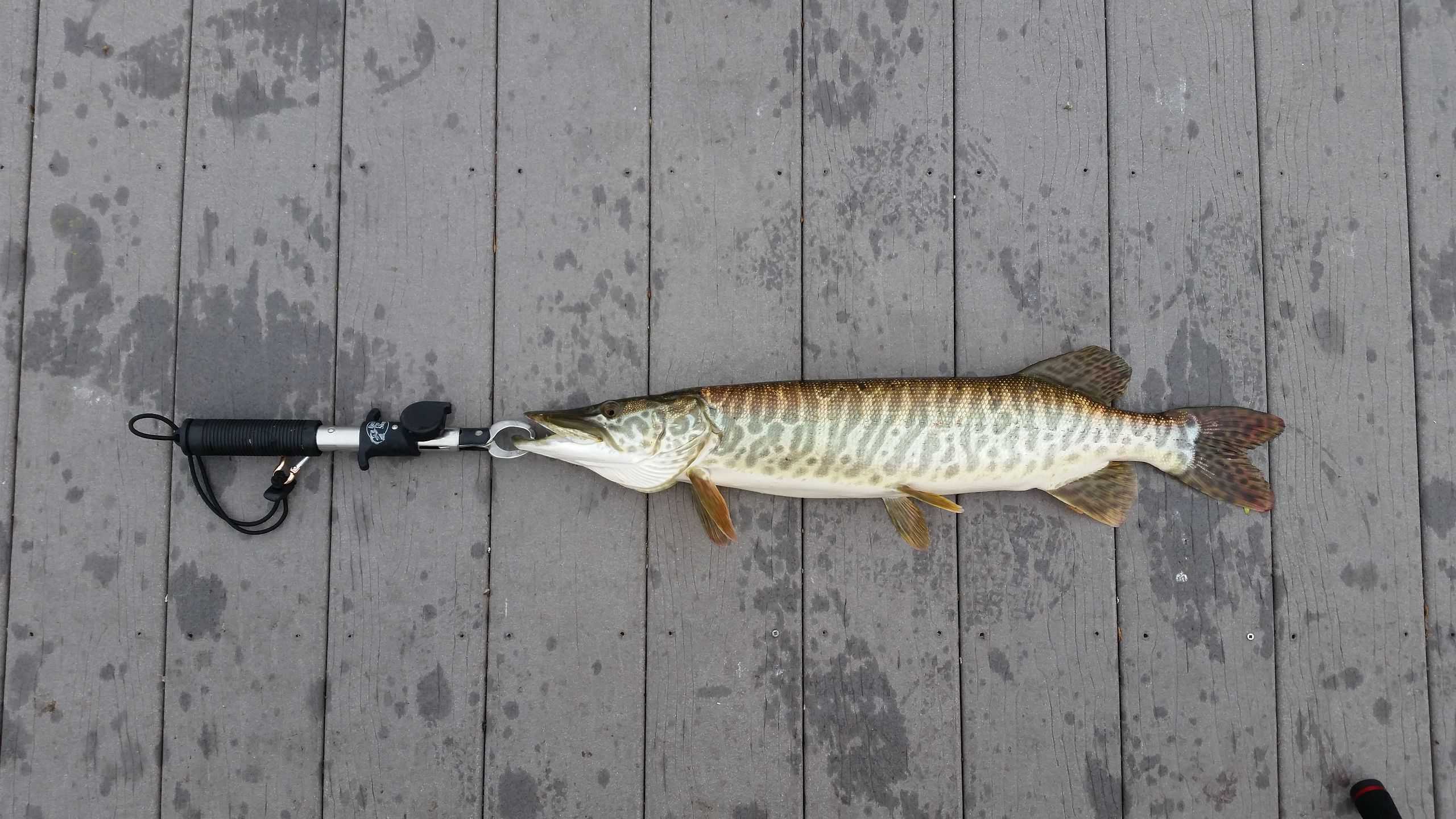
Weight: 51.19 pounds
Length: 54 inches
Water Body: Lac Vieux Desert
Year: 1919
Method: Unavailable
Bait/Lure: Unavailable
The tiger muskellunge (E. masquinongy × lucius or E. lucius × masquinongy) is a hybrid of the muskie and northern pike. The fish is named for the tiger-like stripes along the sides of its body. It is just as toothy and fierce as its parent fish.
These hybrids cannot reproduce. Michigan’s DNR ended its tiger muskie stocking program in the 1990s.
Michigan’s tiger muskie record is also the current world record. That record is unlikely to be broken, considering Michigan’s cancellation of its tiger muskie program.
5. Flathead Catfish
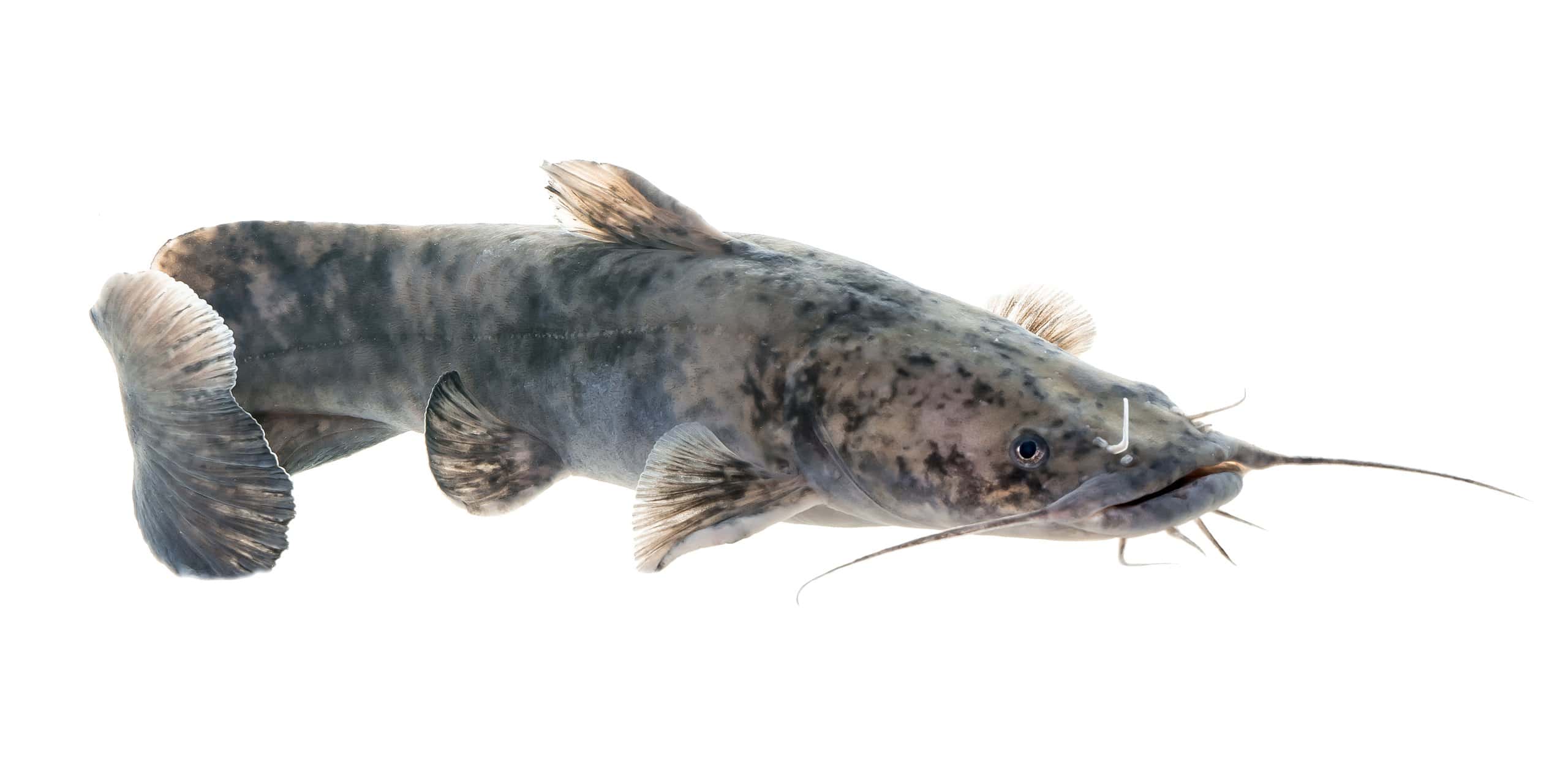
Weight: 53.35 pounds
Length: 48 inches
Water Body: St. Joseph River
Year: 2022
Method: Still fishing
Bait/Lure: Cut Bait
The largest catfish ever caught in Michigan was a flathead catfish (Pylodictis olivaris) weighing over 53 pounds. A mature flathead typically weighs around ten pounds, but individual fish can tip the scales at over 100 pounds.
The flathead catfish is instantly recognizable by its eponymous flat head. It is sometimes known as the shovelhead catfish.
This catfish is not native to Michigan. It is unclear when it was introduced into the state’s waters. There is some evidence of stocking efforts as early as the 1800s. Today, the flathead is present in Lake Erie, Lake Huron, Lake Michigan, and most drainages in Michigan. Rivers such as the Grand, Kalamazoo, and Muskegon are known to produce quality flathead catfish.
4. Black Buffalo
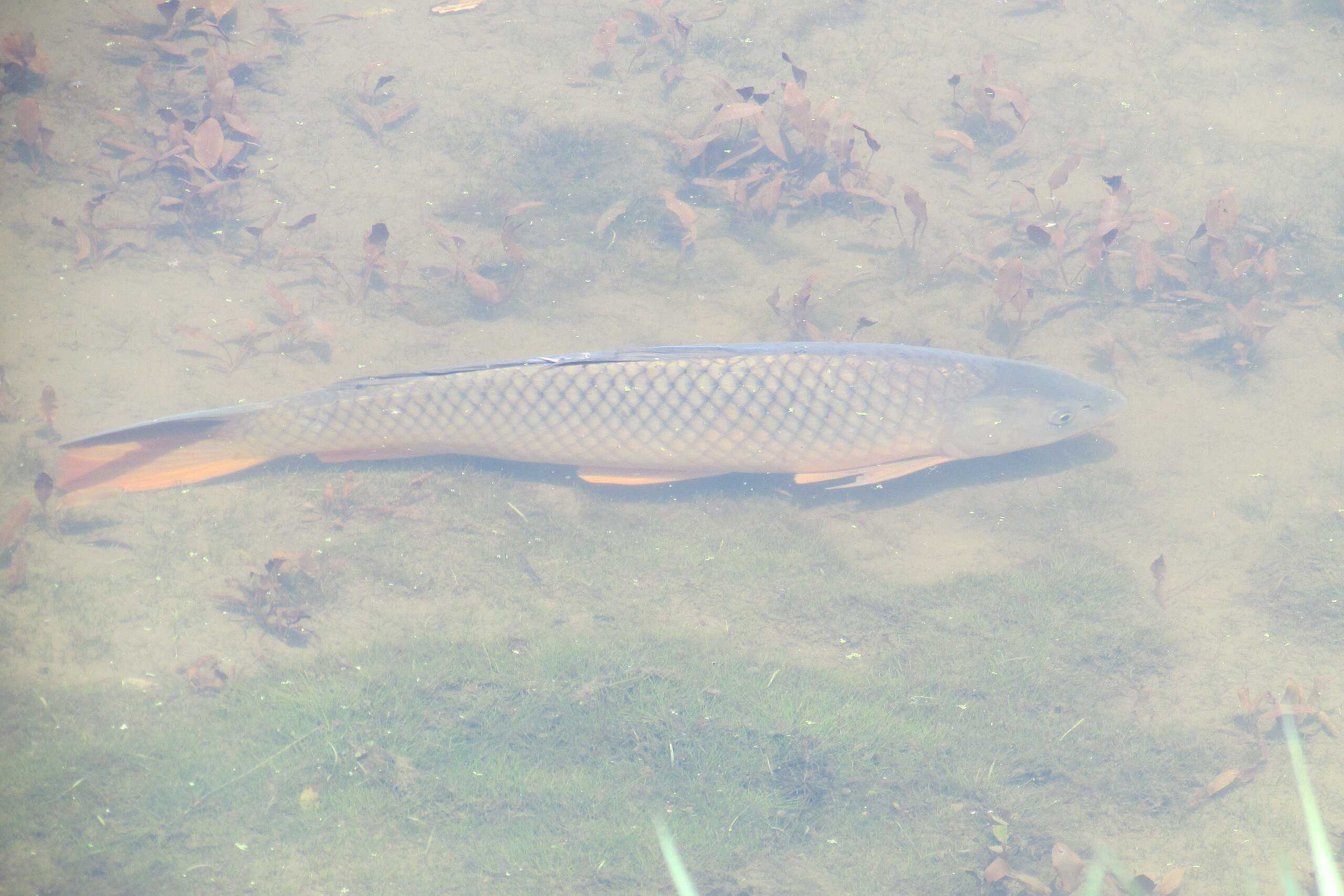
Weight: 54.3 pounds
Length: 42.6 inches
Water Body: Grand River
Year: 2020
Method: Trolling
Bait/Lure: Hot ‘N’ Tot
The black buffalo (Ictiobus niger) looks similar to the bigmouth buffalo. They are usually darker than bigmouth buffalo, with a dark gray or bronze-gray color.
Like the bigmouth buffalo, the black buffalo can live upwards of 100 years. A typical adult black buffalo can weigh 20-25 pounds, but they can grow to over 50 pounds.
While buffalo fish look similar to the common carp, they are not closely related.
3. Great Lakes Muskellunge
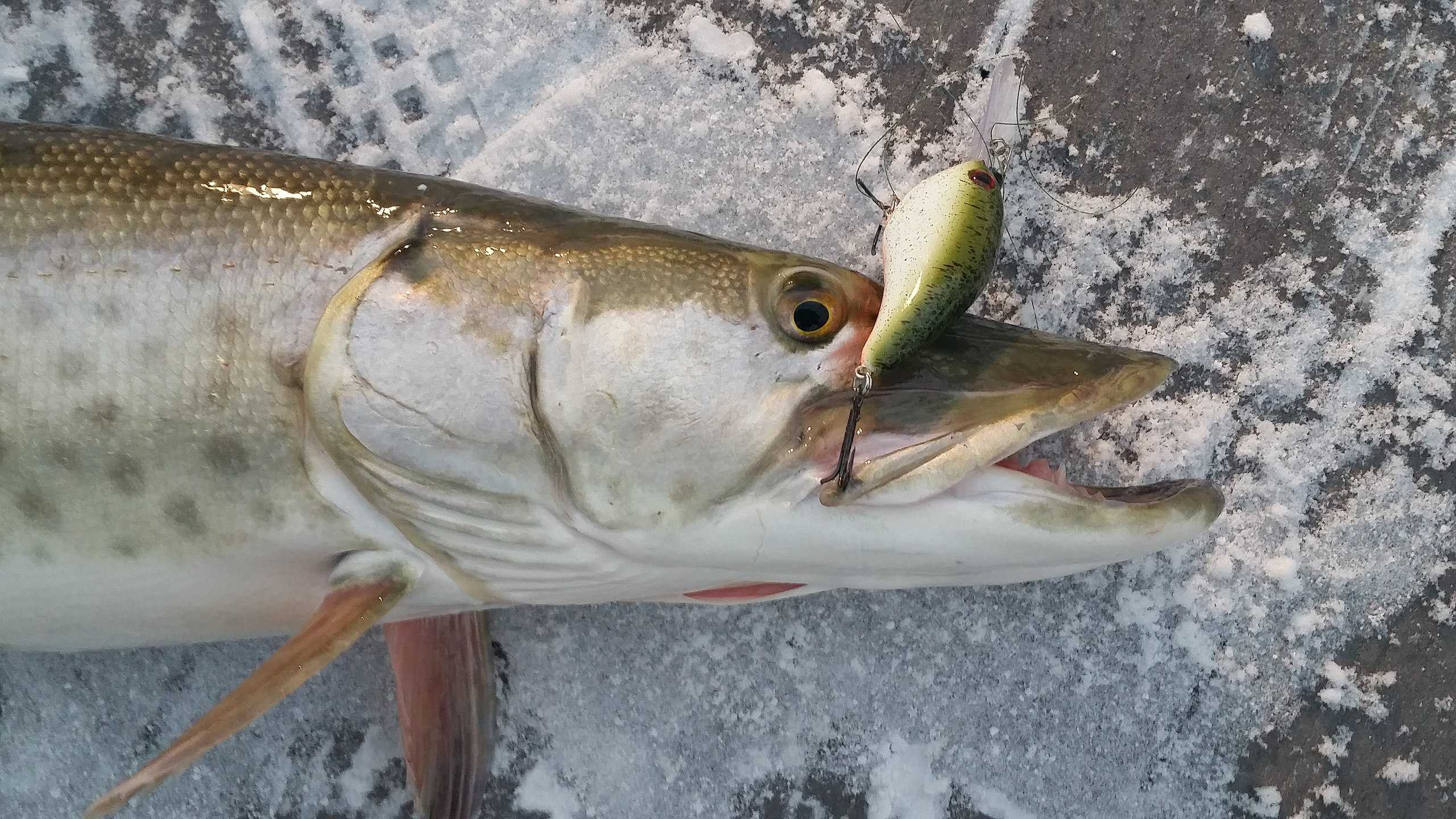
Weight: 58 pounds
Length: 59 inches
Water Body: Lake Bellaire
Year: 2012
Method: Spincasting
Bait/Lure: Minnow
As noted earlier, the Great Lakes muskellunge is one of two strains of muskellunge documented in Michigan’s state fishing records.
The Great Lakes muskie is quite similar to the northern muskie. Great Lakes muskies are commonly found in Lake St. Clair and the Detroit River.
1. (tie) Common Carp
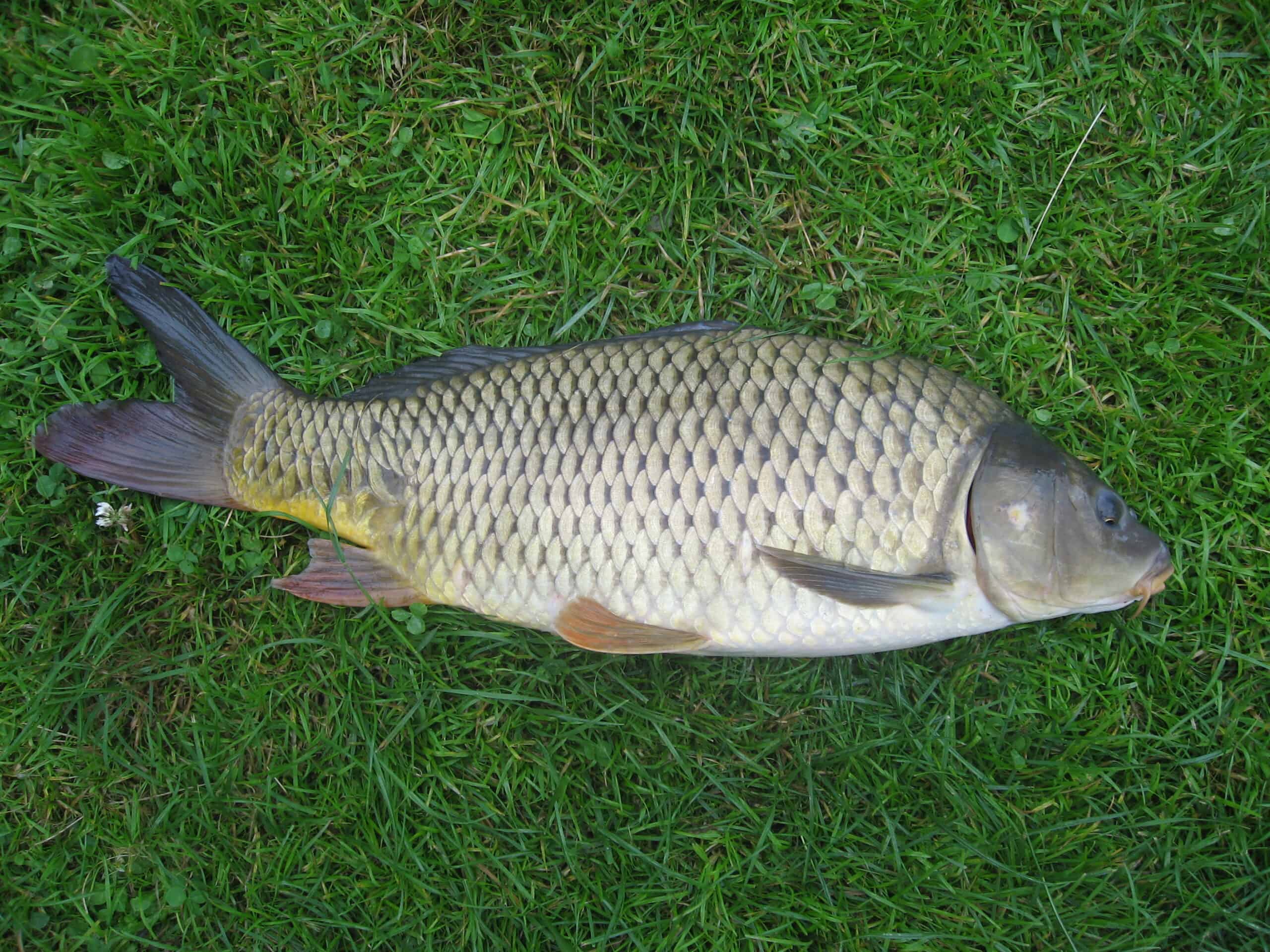
Weight: 61.5 pounds
Length: 47.5 inches
Water Body: Wolf Lake
Year: 1974
Method: Spear
Bait/Lure: N/A
The title of the biggest fish ever caught in Michigan is shared between two fish of different species, the first of which is the common carp (Cyprinus carpio).
This carp is native to Eurasia but was introduced in the U.S. in the mid-1800s. Because the carp had been a food source and a symbol of courage and strength in Asia and Europe, settlers began to import the fish to the U.S. The demand was so strong that the U.S. Commission of Fish and Fisheries launched an official effort to introduce carp to U.S. waters in 1877. This well-intentioned program backfired spectacularly.
Officials thought the common carp would become a prized sportfish and a reliable food source, as it was in Asia and Europe. That did not happen. Instead, the fish spread throughout the nation, becoming one of the most widespread and destructive invasive fish in the U.S.
The common carp thrives in nearly any water condition, including highly polluted water where few other fish species can survive. This hardy fish also reproduces prolifically, making it all but impossible to control its spread. Females lay up to two million eggs. Carp fry can grow up to eight inches long in just the first year.
Common carp are bottom feeders. They uproot vegetation, which has a deleterious effect on the ecosystem. They also stir up mud, turning clear water into a turbid environment. This makes it more difficult for some native fish to feed. Common carp also commonly outcompete native fish for food.
A typical adult common carp measures 15-30 inches long and weighs 5-10 pounds, but fish of 50+ pounds are not uncommon. In Michigan, common carp are now found in the Great Lakes, large inland lakes, and rivers throughout the state.
1. (tie) Lake Trout
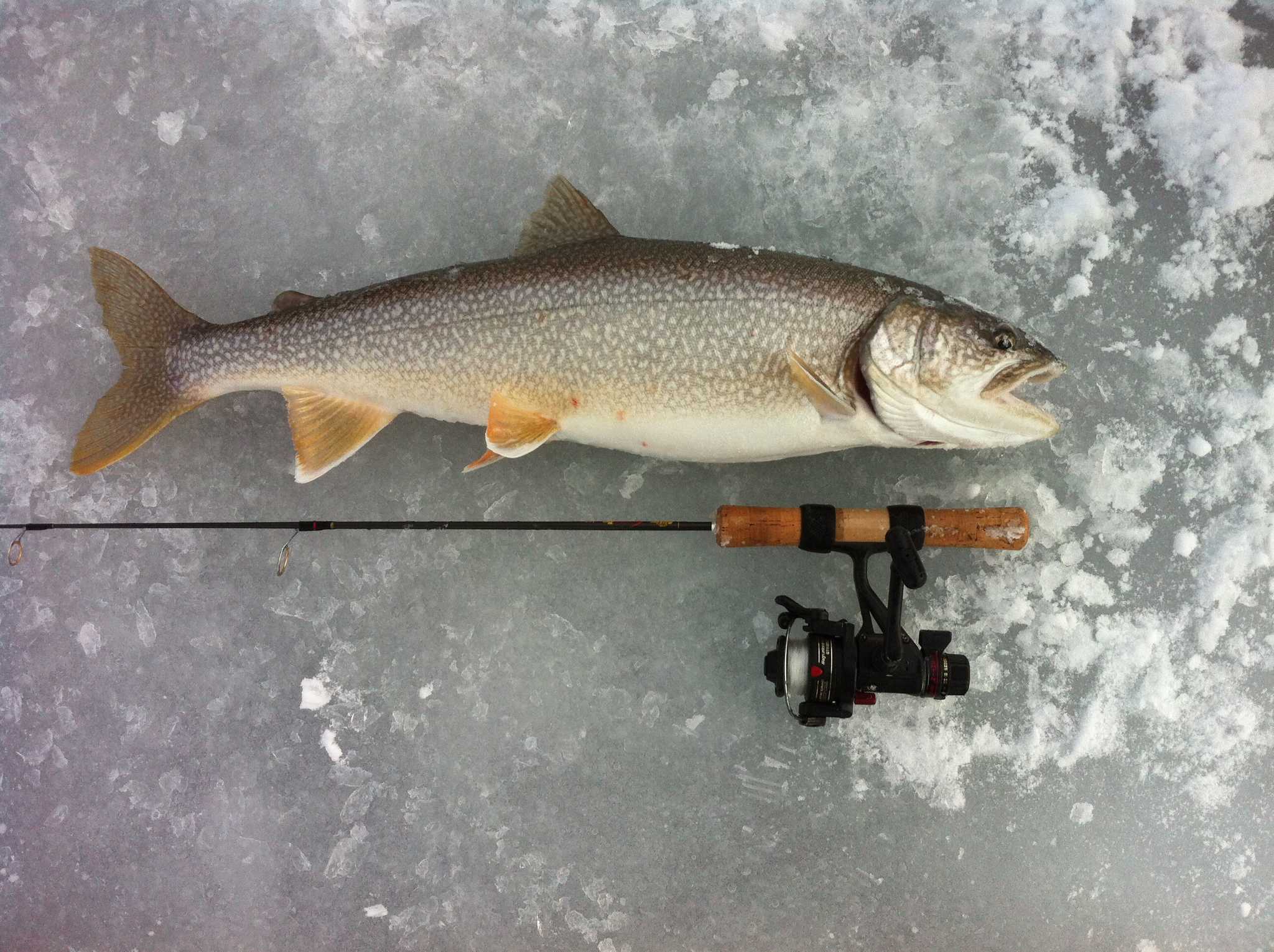
Weight: 61.5 pounds
Length: 49 inches
Water Body: Lake Superior
Year: 1997
Method: Drift fishing
Bait/Lure: Jig
The lake trout (Salvelinus namaycush) is tied with the common carp for the largest fish ever caught in Michigan. Unlike the carp, though, the lake trout is a Michigan native.
Michigan’s lake trout can be found in all of the Great Lakes as well as deep inland lakes. The cold water fish prefers water temperatures from 40-55°F. During colder months, the fish will move into shallow waters. When water temperatures rise in the summer, though, it will move to depths well over 100 feet.
Despite its name, the lake trout is not a true trout. Rather, it is the largest of the freshwater char species. A typical “laker” weighs around ten pounds, but individual fish can grow six to seven times that size. The Michigan record lake trout weighing 61.5 pounds was caught in Lake Superior. The world record lake trout weighed 72 pounds and was caught in Canada’s Northwest Territories.
Commercial overfishing damaged the lake trout population in the Great Lakes, as did the introduction of the invasive sea lamprey. Lampreys are parasitic fish that attach to other fish to feed on their bodily fluids. Chemical contaminants also may have hindered the reproduction of lake trout. By the mid-1950s, the lake trout was teetering on extinction in the Great Lakes. Thankfully, aggressive conservation efforts stretching over decades have helped the lake trout stage quite a comeback. With continued management, this native apex predator should be patrolling the Great Lakes for generations to come.
Sponsored: Want to Retire Early? Here’s a Great First Step
Want retirement to come a few years earlier than you’d planned? Or are you ready to retire now, but want an extra set of eyes on your finances?
Now you can speak with up to 3 financial experts in your area for FREE. By simply clicking here you can begin to match with financial professionals who can help you build your plan to retire early. And the best part? The first conversation with them is free.
Click here to match with up to 3 financial pros who would be excited to help you make financial decisions.
The post 25 Largest Fish Ever Caught in Michigan appeared first on 24/7 Wall St..